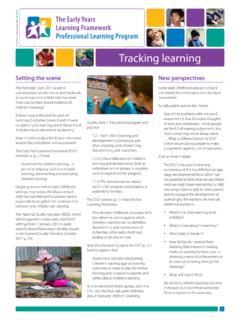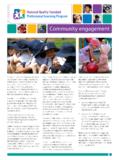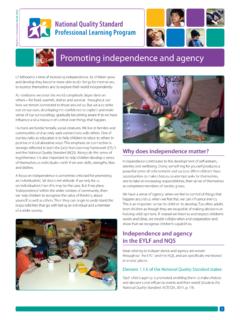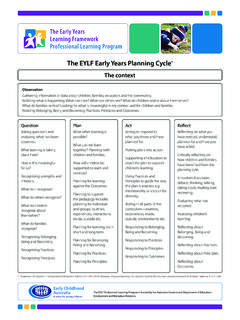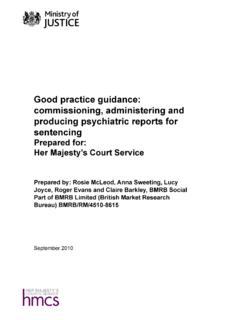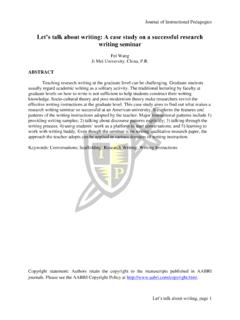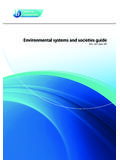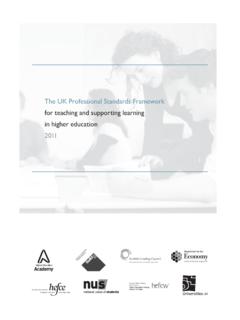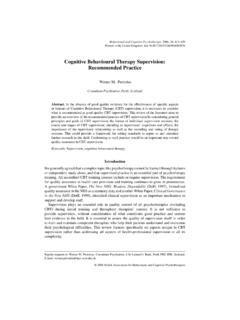Transcription of Links between the EYLF, the NQS, and everyday …
1 Links between the eylf , the NQS, and everyday practice Introduction This document aims to demonstrate how a focus on one area of learning Quality Area 3 in the National Quality Standard (NQS) the physical environment . has connections and implications for practice across the whole of the seven Quality Areas. It also demonstrates how the physical environment can support children's learning across the five learning Outcomes as stated in the Early Years learning Framework ( eylf ). The document has been designed to support educators to see the connections In essence, a well organised learning environment has the potential to underpin good between the eylf and the NQS and to see practice across all Quality Areas in the NQS and the five learning Outcomes specified in the elements, not as individual items to be the eylf . ticked off' but rather part of a larger holistic approach to quality programs for children.
2 learning environments are one of the key practices from the eylf . A well organised environment is: welcoming vibrant and flexible responsive to children and their changing needs, interests and abilities one that invites experiences, interactions, risk-taking, discovery, connections to nature, conversations, play and collaboration one that has a sense of place and purpose for resources, materials and experiences consistent and predictable well resourced and well maintained interesting and engaging (absorbs children in complex, deep learning experiences rather than shallow or superficial experiences). contains open-ended, complex materials that can be used in many ways and can be used again and again without becoming boring balance of experiences/types of experiences. We value space because of its power to organise, to promote pleasant relationships between people, to create a handsome environment, provide changes, promote choices and activity, and its potential for sparking all kinds of social, affective and cognitive learning Louis Malaguzzi.
3 1. eylf the physical environment . connections to the big ideas' of Belonging, Being and Becoming Belonging Environment supports belonging by being welcoming to children and families, warm and inviting, consistent and predictable and gives a sense of ownership and involvement. Environment that allows children to participate in decisions about how it is arranged, choice of available materials, provides sense of belonging. Children and families can find their culture, background, identity reflected in a way that makes them feel good about themselves. Environment that also includes parents makes them feel part of what goes on too. Environment promotes/allows time for genuine relationships to occur . children and children, educators and children, educators and parents, parents and parents. Being Environments that allow time and space for children to lose themselves in what they are doing open ended resources are more likely to encourage this.
4 Space and time to be alone, to be together, to finish something, to continue something, to be with an adult, to be away from adults. Mixture of spaces small, large, medium, private, open, secret and public. Becoming Environments that provide time/space/resources to extend on children's learning and interests. Environment that allows educators the time and freedom to connect deeply with children and their learning in order to guide/support where it goes to next. Environment where children have the chance to develop skills, recognise talents and potential for the future (how do we know what children will be good at if they have no time to get good at anything blocks of time, repetition and time to practice). Materials that allow development of skills over time (not novelty art and craft). Environments that show educators understanding of how literacy and math develop and support children's learning in these areas (not tokenistic reading/writing materials).
5 Environments that encourage increasing independence. 2. eylf Outcomes Outcome 4 Children are confident and involved learners Connections to the Environment set up to encourage physical environment exploration, choice, curiosity, creativity. Outcome 1 Children have a Materials that encourage problem strong sense of identity solving; that lend themselves to skill development ( children can get Welcoming environment that provides better at using them with practice, sense of belonging helps children to time and support). feel safe and secure. Environment allows children choices Environment that provides challenge and ability to use resource and and risk encourages agency and helps materials for their own ends (ask why children to feel sense of achievement, not? Rather than why?). (self esteem/identity/feeling good about yourself ), What is my influence?
6 '. Materials and experiences that encourage perseverance, persistence, Environment supports children's curiosity, problem-solving. relationships with each other and collaborate constructive relationships Environment provides open-ended rather than conflict filled/disruptive materials not single use or relationships. predetermined and complex holistic experiences (rather than learning Environment supports adult-child skills in isolation). relationships that help children to feel Environment that encourages secure/belonging. collaborative play and thinking Outcome 2 Children are Outcome 3 Children have a (children to work together). connected with and contribute to strong sense of wellbeing Outcome 5 Children are effective their world The environment supports wellbeing communicators Environment that encourages positive through promoting healthy diet and Environment that encourages and relationships, active decision making physical activity.
7 Supports communication (not too and collaborative play helps to create noisy, encourages/provides space Supports emotional wellbeing sense of community. for small groups or children to work through providing range of different spaces opportunities for challenge, together). Environment that has sense of order, encourages children to also care for/ opportunities for collaboration, Environment that allows educators time look after it. opportunities for solitude that to engage with children to talk, discuss, respond to children's mood. listen, have real conversations). Environment that engages with the outside world rather than being Environment that is inclusive/reflective Examples of communication (pictures, isolated from it (outward rather than of children and families background/ symbols, words/text) are evident in the inward looking).
8 Culture/identity. environment and are used by educators to draw children's attention to aspects Sustainable/natural environment helps Environment encourages persistence, of communication. children to develop awareness of and curiosity, genuine achievement . respect for the environment (How is contributes to feeling good about Environment that provides space for sustainability embedded into daily yourself. children to display their work so that routines and environments?). their communication' is visible to others. Environment that promotes autonomy/. Environment that reflects/ independence as children develop and Orderly environment introduces acknowledges the history of place and become more competent at looking children to ideas of classification, contribution of Aboriginal people and after themselves. sorting etc. culture to Australian society.
9 Environment that allows educators to Environment provides access to respond to individual children's needs technology for children to explore rather than always treating them as and use (cameras, computers etc.). a group. 3. National Quality Standards Connecting all quality areas to all of the standards. Quality Area 1 Educational program and practice Standard An improved learning environment informs the development of a curriculum that enhances each child's learning and development Elements Curriculum decision making will include decisions about the environment what is available, how it is arranged and set up link to eylf ( learning environments). Current knowledge, ideas, interests etc. should be reflected in the environment and also how the environment is used. A well organised environment supports routines such as calm, unhurried learning opportunities, ( materials to hand out where routines take place and where space is available).
10 Displays/notice boards can be an effective way to share documentation with families. Physical environment helps determine how accessible a service is. An inviting environment encourages participation. How the environment is setup ( availability of resources, access to inside/outside . ability to move around centre) either encourages or discourages children to make decisions for themselves. Standard Educators and coordinators are focused, active and reflective in designing and delivering the program for each child Examples of children's work/ learning is documented, displayed, and available to families. Engaging environment encourages ideas, questions and creativity for educators to build. A flexible, well resourced environment allows educators to respond to interests as they arise. Space for staff to meet/work/discuss will help this to happen (space that is conducive to discussion/reflection).
